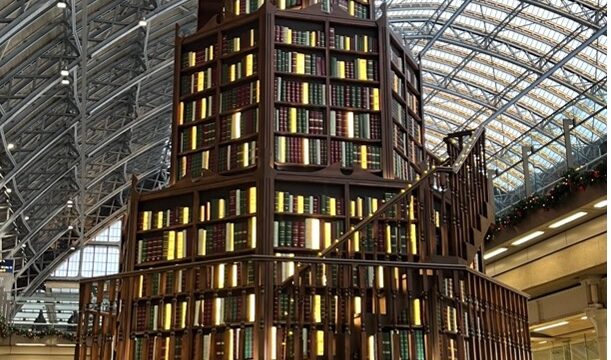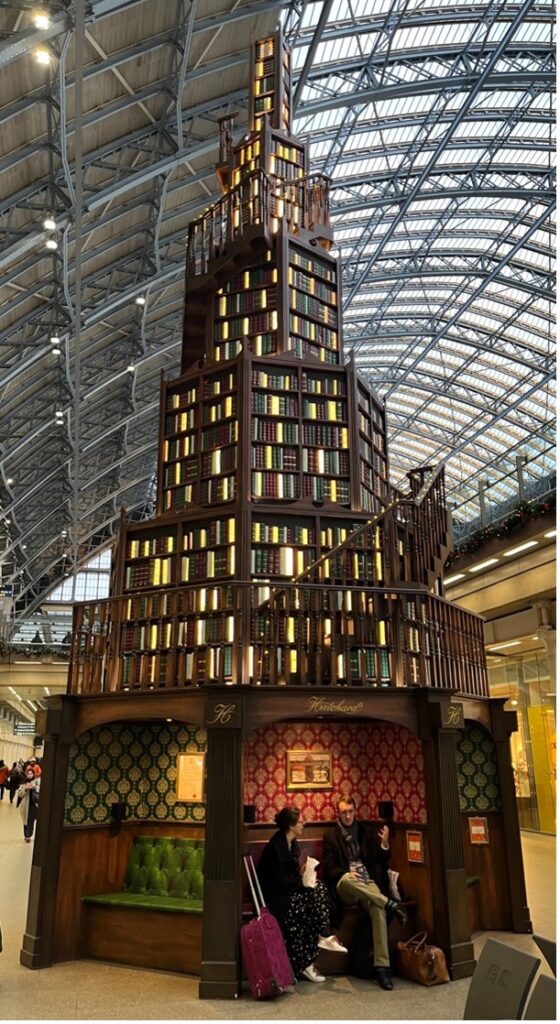Earlier this year I wrote a piece for SHARP news on the new Penguin Books Vending Machine at Exeter Railway Station, including other Penguin initiatives around selling books. Bookending what has been a bumper year for this topic, earlier last month a spectacular Christmas tree was unveiled at St Pancras Station, a collaboration between Penguin and Hatchards[1].
This “magical reading experience”[2], an “ode to the wealth of literature that transports us to exciting and novel worlds”[3], situated in one of London’s busiest stations, is 12 metres high, and has 270 shelves with over 3800 hand-painted books. At the base are eight booths where people can sit and listen to 5-minute extracts from audiobooks provided by Penguin Books[4].


This tree has unleashed another veritable sleigh-load of enthusiastic responses from the media and the general public: St Pancras Station’s official Instagram account has logged over four thousand likes for its post announcing the launch[5], and Secret London’s TikTok has clocked over twenty-three thousand likes on its similar post[6]. A search on Twitter (X) for #stpancraschristmastree or #hatchardschristmastree will result in a deluge of responses. Although there are some voices of complaint in the mix, mainly concerned that it is not actually a tree, the vast majority are of the “wow!” “gorgeous” “I love this so much” variety.
The accessibility of the tree, which stands in the middle of the concourse at St Pancras, just as the Penguin Books Vending Machine does at Exeter railway station, allows for interactions between people and these bookish objects in ways that actual bookshops cannot. This is perhaps more obvious at St Pancras, where the book tree stands literally outside of the Hatchard’s shop. The countless amount of selfies and videos posted on social media give ample evidence that people like to be associated with both objects: indeed, the delight over the book vending machine seems even more intriguing when compared to that extended to the book Christmas tree, which is at least a creatively constructed thing, and so more aesthetically rewarding to pose beside. However, the Hatchard’s Christmas tree is, at root (sorry!) a fake…the books painted on the sides are not real, and cannot be taken from the equally fake shelves. And yet the purpose of it is, as Wendy Spinks, Commercial Director for St Pancras says, to promote book buying:
From real-life travel experiences to the fantastical lands of our imagination, we hope that festive visitors feel the magic and are inspired to pick up or gift their loved ones the most timeless gift of all, Books.[7]
The Exeter Penguin Book Vending Machine does help provide the books for people to buy —albeit a very small, curated selection — but does the Hatchard’s Christmas Tree push people into the adjacent shop? I scanned as many posts on social media as I could, and couldn’t find many where book purchases were highlighted alongside the visit to the tree itself. I asked one of my MA Publishing students, currently working within the shop, what she thought, and she was adamant in her reply that the tree had significant impact on shop sales, reporting anecdotally that several customers had told her they’d come in because they’d seen the tree, or because they’d been intrigued by the audio snippets and advertisements for books in the booths[8]. So, if this is the case, it poses even more provocative questions about our relationships with books and bookish things, and how we portray these.
Jessica Pressman recalls Gatsby’s library of uncut books, constructed to help his image as a man of culture and intellect[9]. Bookshelves, she asserts (as we found out during the pandemic lockdowns, as backgrounds to Zoom calls), are a means of “self-fashioning and self-representation”[10]. I believe we can add another layer of response to the enquiry which follows, looking at how we project our constructed bookish selves out into the world, by offering the Hatchard’s Christmas tree as a supreme example of how a digital image of a physical book-related object plays directly to this desire to be seen as bookish. The draw might be to the actual tree, in its physical location, but the visit offers a chance to record that experience, and post it out to followers, in a digital format. Many of the responses to posts like this express envy and admiration: a heady mix of approval from followers who validate this huge decoration as the apotheosis of bookish affiliation. Yet, as has already been noted, the book tree does not contain real books – and even the extracts offered to those who sit in any of the booths (on the hard seats painted to look cushioned and cozy) are audio snippets. The Hatchard’s Christmas tree is a marker, an homage, to the bookish in all of us (or most of us — in the spirit of honesty, I should say that there are posts on social media from people who are not at all enamored of it; for example, complaining that it’s not Christmassy enough, or that you cannot actually climb up the stairs). The video posted on Instagram by St Pancras Station, showing a sped-up look at how the tree was built, stresses the “hand-painted” books, and uses music by John Williams, the composer who wrote the music for the first Harry Potter films[11]. ‘The House’ is a piece from the Home Alone film, however — cleverly bringing together the associations of Potter and Christmas in an evocative backing sound to the construction of the tree. The elements which this tree brings together are all about the igniting of different, complementary, well-designed bookish triggers, and this is why it works as a totem for everyone who wants to be seen as, or who identifies as, bookish.
In a further tug on nostalgic connotations of cozy quiet corners curled up with a book, Luke Taylor, Retail Director for Hatchard’s, leans in on the rose-tinted, evoking steam trains with his use of “whistling” and persuasively suggesting that peace and quiet can be found under this tree, despite it being set in one of the busiest transport hubs in London:
Whether we are young or old, books offer an escape from the hurly burly bustle of the modern world that no other medium can compete with; and there are few better ways to enjoy a good read than whistling through the countryside on a train! We are delighted to be partnering with St. Pancras International to bring this joy to the many station visitors, allowing people to escape, relax and enjoy literature for a few moments with the station tree. What a start to the festive season![12]
It perhaps did not help my suggestibility to this vision that my own train journey into London had been on a train so packed there were no seats, and certainly no chance to enjoy a book: but, nevertheless, I did feel that joy on seeing the tree for myself. I took countless pictures of it from every angle, sat in as many of the booths underneath that were free, and did carry on with my walk to work feeling more festive, less frazzled, and more uplifted by experiencing this bookish “tree-t” than might be deemed seemly in a middle-aged Professor. I was sad not to have been able to share the experience with other bookish friends, and couldn’t wait to at least send them the pictures so we could wonder at it together, and was reminded by this what Pressman says: that bookishness is “also about human connection”[13].
So, I am offering this brief piece as a celebration of books, bookshops, and bookish things, and also of all those people connected to them. It’s Christmas: may all your TBR piles increase with bounty in the coming weeks, and may you all have time to read in peace, on trains, planes, and in automobiles, as you travel to meet up with family and friends!
Samantha Rayner, UCL.
[1] See https://tinyurl.com/mrx5cr5u.
[2] See https://tinyurl.com/mrx5cr5u.
[3] Wendy Spinks, https://stpancras.com/news-events/st-pancras-2023-christmas-tree.
[4] See https://stpancras.com/news-events/st-pancras-2023-christmas-tree.
[5] See: https://www.instagram.com/stpancrasinternational/.
[7] See https://stpancras.com/news-events/st-pancras-2023-christmas-tree.
[8] Email from Ella Shindler to me, 6th December 2023. Referred to with permission from Ella.
[9] Jessica Pressman, Bookishness (Columbia University Press, 2020) p. 33.
[10] Pressman, p. 34.
[11] See https://www.instagram.com/p/CzMQHIqo8rE/.
[12] See https://stpancras.com/news-events/st-pancras-2023-christmas-tree.
[13] Pressman, p. 150.




